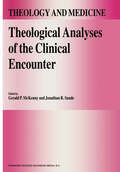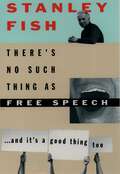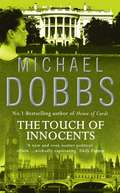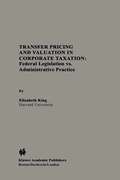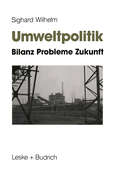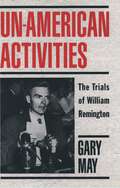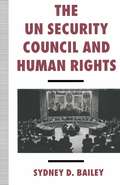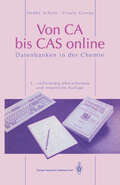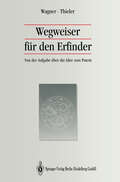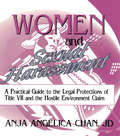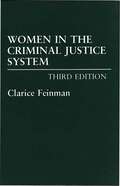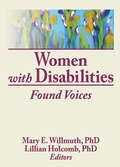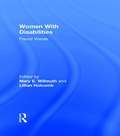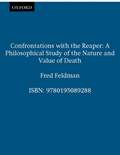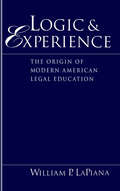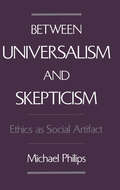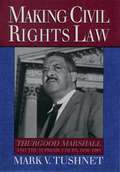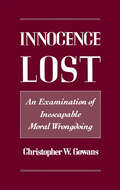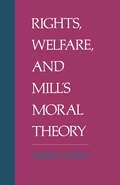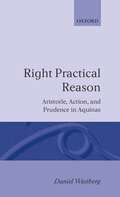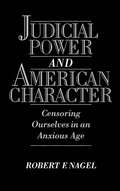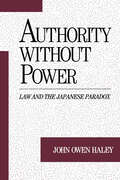- Table View
- List View
Theological Analyses of the Clinical Encounter (Theology and Medicine #3)
by Jonathan R. Sande Gerald P. McKennyEfforts to evaluate the clinical encounter in terms of autonomous agents governed by rationally justified moral principles continue to be criticised. These essays, written by physicians, ethicists, theologians and philosophers, examine various models of the clinical encounter emerging out of these criticisms and explore the prospects they offer for theological and religious discourse. Individual essays focus on the reformulation of covenant models; revisions of principles approaches; and topics such as power, authority, narrative, rhetoric, dialogue, and alterity. The essays display a range of conclusions about whether theology articulates generally accessible religious insights or is a tradition-specific discipline. Hence the volume reflects current debates in theology while analysing current models of the clinical encounter. Students, professionals, and scholars who find themselves at the intersection of theology and medicine will welcome these voices in an ongoing conversation.
There's No Such Thing As Free Speech: And It's a Good Thing, Too
by Stanley FishIn an era when much of what passes for debate is merely moral posturing--traditional family values versus the cultural elite, free speech versus censorship--or reflexive name-calling--the terms "liberal" and "politically correct," are used with as much dismissive scorn by the right as "reactionary" and "fascist" are by the left--Stanley Fish would seem an unlikely lightning rod for controversy. A renowned scholar of Milton, head of the English Department of Duke University, Fish has emerged as a brilliantly original critic of the culture at large, praised and pilloried as a vigorous debunker of the pieties of both the left and right. His mission is not to win the cultural wars that preoccupy the nation's attention, but rather to redefine the terms of battle. In There's No Such Thing as Free Speech, Fish takes aim at the ideological gridlock paralyzing academic and political exchange in the nineties. In his witty, accessible dissections of the swirling controversies over multiculturalism, affirmative action, canon revision, hate speech, and legal reform, he neatly eviscerates both the conservatives' claim to possession of timeless, transcendent values (the timeless transcendence of which they themselves have conveniently identified), and the intellectual left's icons of equality, tolerance, and non-discrimination. He argues that while conservative ideologues and liberal stalwarts might disagree vehemently on what is essential to a culture, or to a curriculum, both mistakenly believe that what is essential can be identified apart from the accidental circumstances (of time and history) to which the essential is ritually opposed. In the book's first section, which includes the five essays written for Fish's celebrated debates with Dinesh D'Souza (the author and former Reagan White House policy analyst), Fish turns his attention to the neoconservative backlash. In his introduction, Fish writes, "Terms that come to us wearing the label 'apolitical'--'common values', 'fairness', 'merit', 'color blind', 'free speech', 'reason'--are in fact the ideologically charged constructions of a decidedly political agenda. I make the point not in order to level an accusation, but to remove the sting of accusation from the world 'politics' and redefine it as a synonym for what everyone inevitably does." Fish maintains that the debate over political correctness is an artificial one, because it is simply not possible for any party or individual to occupy a position above or beyond politics. Regarding the controversy over the revision of the college curriculum, Fish argues that the point is not to try to insist that inclusion of ethnic and gender studies is not a political decision, but "to point out that any alternative curriculum--say a diet of exclusively Western or European texts--would be no less politically invested." In Part Two, Fish follows the implications of his arguments to a surprising rejection of the optimistic claims of the intellectual left that awareness of the historical roots of our beliefs and biases can allow us, as individuals or as a society, to escape or transcend them. Specifically, he turns to the movement for reform of legal studies, and insists that a dream of a legal culture in which no one's values are slighted or declared peripheral can no more be realized than the dream of a concept of fairness that answers to everyone's notions of equality and jsutice, or a yardstick of merit that is true to everyone's notions of worth and substance. Similarly, he argues that attempts to politicize the study of literature are ultimately misguided, because recharacterizations of literary works have absolutely no impact on the mainstream of political life. He concludes his critique of the academy with "The Unbearable Ugliness of Volvos," an extraordinary look at some of the more puzzing, if not out-and-out masochistic, characteristics of a life in academia. Penetrating, fearless, and brilliantly argued, There's No Such Thing as Free Speech captures the essential Fish. It is must reading for anyone who cares about the outcome
The Touch of Innocents
by Michael DobbsIt is always the innocent who suffer to make the powerful rich.A gripping thriller from the author of the Goodfellowe Series.
Transfer Pricing and Valuation in Corporate Taxation: Federal Legislation vs. Administrative Practice
by Elizabeth KingTransfer Pricing and Valuation in Corporate Taxation analyzes the disparities between both federal statutes and regulations, and r- ulations and administrative practice, in a highly controversial area of corporate tax policy: intra-company transfer pricing for tax p- poses. It addresses issues that often mean millions of dollars to in- vidual corporations, and a significant fraction of the federal gove- ment’s revenue base. These disparities between law, regulations, and administrative practice are concerning on a number of grounds. First, they - pose considerable economic costs by inducing corporations to engage in a variety of “rent-seeking” activities designed to reduce their - pected tax liabilities, and by requiring the IRS to devote still more to enforcement efforts that are very often futile. Second, they are in- ; herently undemocratic. Administrative practice is currently ad hoc by relying on dispute resolution procedures that can and do yield very different settlements on disputed tax issues from one case to another, the IRS often ends up treating similarly situated cor- rations very differently. Moreover, to the extent that the disp- ity between statute and implementation reflects the IRS’s failure to carry out Congress’ will, the laws passed by duly elected officials are effectively being superseded by administrative procedure, developed incrementally by individuals who are not answerable to an electorate.
Umweltpolitik: Bilanz, Probleme, Zukunft
by Sighard WilhelmUmweltpolitik verliert sich heute in Details. Ihr Erfolg entscheidet sich nicht in diesen oft hochspezialisierten Fragen, sondern darin, ob die weithin aner kannten Leitgedanken verwirklicht werden. Für eine Orientierung über Wege aus der Umweltkrise wird einleitend der naturwissenschaftliche Hintergrund der Umweltpolitik beschrieben, der bisher zu wenig beachtet wurde. Es folgt eine Darstellung und Bewertung der bisherigen Umweltpolitik in der Bundesrepublik. Die Erfolge, aber auch die zahlreicheren Mängel, Defizite, Rückschläge werden vorgeführt; sie sollten als Erfahrungen und Maßstäbe für die künftigen Entscheidungen dienen. In einem abschließenden Kapitel werden Anforderungen an die künftige Umweltpolitik formuliert und ihre Er folgsaussichten auf der internationalen und der deutschen Ebene beurteilt. Die Schwierigkeiten, vor denen wir mit unserer Umweltpolitik heute ste hen, sind vermutlich größer, als sich die meisten vorstellen; die Erfolgsaus sichten sind wahrscheinlich schlechter, als uns für die nächste Generation lieb sein kann. Es scheint nicht nur ein "grünes Krisenszenario" zu sein, son dern der objektiven Entwicklung zu entsprechen, daß Erfolg oder Mißerfolg der Umweltpolitik in den nächsten Jahrzehnten tatsächlich über Fortbestand l oder Ende der uns bekannten Zivilisation entscheiden . Dieses Buch wurde geschrieben als Appell für eine aktiv gestaltende Umweltpolitik. Frau Claudia Wolff und Herr Oliver Schwork haben mich als studentische Hilfskräfte unterstützt. Frau Birgit Katsaros beschaffte mir wieder die erfor derliche Literatur. Mein Kollege Dr. Manfred Röber gab mir verschiedene Anregungen. Ich danke ihnen herzlich.
Un-American Activities: The Trials of William Remington
by Gary MayIn 1948, William W. Remington was one of the bright young men in the Truman administration. He was tall and handsome, a product of Dartmouth and Columbia. From 1940 on, he had risen through government ranks, serving on wartime boards, the President's Council of Economic Advisors, and eventually as a major official in the Department of Commerce, with a promising future ahead. By 1954, however, Remington was dead--assassinated in his cell by a team of inmates in a high-security Federal prison. In Un-American Activities, historian Gary May tells the fascinating story of William Remington--a story of intrigue, injustice, government corruption, and anti-Communist hysteria. May labored for eight years in reconstructing Remington's case, searching through FBI files, government documents, and waging an epic battle against then-U.S. Attorney Rudy Guiliani to become the first historian to obtain access to grand jury records. The result is a brilliant account of one man's tragic odyssey and a government run amok. Remington's future collapsed in 1948, when he was charged with being a Communist and a Soviet spy. The accuser was Elizabeth Bentley, an admitted ex-Communist herself and a former courier for Soviet spymasters. Remington's life fell into a whirlpool, as he fought government improprieties, illegalities, and the assumption he was guilty. Cleared by government loyalty boards, he was indicted by a grand jury--whose foreman was secretly helping Elizabeth Bentley prepare her memoirs. Remington suffered through two trials for perjury, and the chief witness against him was his own embittered ex-wife. He was convicted and sentenced to the federal penitentiary at Lewisburg, Pennsylvania, where his reputation as a Communist preceded him. But May's account also offers fascinating insight into the depth of Soviet penetration into wartime America: As he follows Remington's life, from the radical circles at Dartmouth and the Tennessee Valley Authority in the 1930s through his Washington career, he finds that Remington may well have been guilty of the charges against him. Gary May is one of the leading historians writing about postwar America. His first book, China Scapegoat, won the Allan Nevins Prize and was hailed as "as well as a novel, as powerful as a good film" by the The Los Angeles Times. Here he brings his analytical and narrative skills to bear on one of the forgotten stories of the McCarthy era, uncovering a gripping tale of espionage, corruption, and personal tragedy.
The UN Security Council and Human Rights
by Sydney BaileyThe UN Charter establishes six 'principal organs'. Five of these are expressly authorized or permitted to deal with human rights. The single exception is the Security Council, but the Council has increasingly concerned itself with human rights inside sovereign states. This book recounts how this trend has developed in the Security Council, reluctantly at first but since 1989 with some enthusiasm and responsibility. Some Third-World countries are uneasy at this development, fearing that the Security Council, dominated by a single superpower, will interfere in the internal affairs of states without the agreement of the government concerned.
Wegweiser für den Erfinder: Von der Aufgabe über die Idee zum Patent
by Michael Wagner Wolfgang ThielerDas Thema Erfindung wird ganzheitlich von der Aufgabenstellung bis zur Patentverwertung behandelt. Die Autoren, selbst Industriefachleute, geben dazu wertvolle Tips und Tricks aus der Praxis.
Women and Sexual Harassment: A Practical Guide to the Legal Protections of Title VII and the Hostile Environment Claim
by Robert C Berring Anja A ChanHere is a valuable guide that saves researchers investigating sexual harassment in the workplace enormous amounts of time and money. Focusing on the hostile environment claim under Title VII of the Civil Rights Act of 1964, Women and Sexual Harassment is a complete resource tool. In one easy-to-use volume, it provides a detailed background and history of the hostile environment claim as well as an extensive guide on how to use and where to find the best resources available on this topic. Unlike some legal books, Chan’s book does not require cover-to-cover reading to access pertinent information. Anyone, whether they are interested in the specifics of the hostile environment claim or sexual harassment in general, will be able to locate the information they’re looking for with the help of this handy guide. It saves enormous amounts of time, effort, and money for researchers by providing extensive listings and evaluations of statutes, cases, agency decisions, law review articles, annotations, and books containing information on this subject. Readers can use the book to get a better understanding of the hostile environment claim or use it like a dictionary to pinpoint the specific resources that will be most useful to their area of research. Women and Sexual Harassment is logically divided into five complete parts to make it easy to use: Part 1: Clearly explains how to best use the book to access specific information. Part 2: Describes the history and present state of the hostile environment claim in a manner that is to the point, yet is more thorough than descriptions of the claim found in articles, cases, or other sources. Part 3: Research guide--Directs researchers to the best sources for information, categorized by type and area. Includes tips that will save hours in the library and will help researchers find the most up-to-the-minute articles and cases. Part 4: Bibliography of primary legal sources--Covers statutes, regulations, and case law on the hostile environment claim and sexual harassment. Part 5: Bibliography of secondary sources--Includes books, articles, surveys, and legislative history.The annotated bibliography, broken down by type of source and type of information, not only points researchers in the right direction but also steers them away from sources that seem valuable from their title, but are in fact not worthwhile. The insightful written analysis of the hostile environment claim alone provides researchers unfamiliar with the subject with a clearly written history and definition of the claim, its key elements, employer liability, statute of limitations, remedies, considerations of discovery and evidence, and related claims. Women and Sexual Harassment is an invaluable guide for all types of researchers including victims of sexual harassment considering filing a hostile environment claim, scholars interested in women’s issues, attorneys unfamiliar with this area, employers interested in limiting their liability by taking steps to prevent sexual harassment in their workplaces, and law students in any level of courses related to sex discrimination or sexual harassment.
Women and Sexual Harassment: A Practical Guide to the Legal Protections of Title VII and the Hostile Environment Claim
by Robert C Berring Anja A ChanHere is a valuable guide that saves researchers investigating sexual harassment in the workplace enormous amounts of time and money. Focusing on the hostile environment claim under Title VII of the Civil Rights Act of 1964, Women and Sexual Harassment is a complete resource tool. In one easy-to-use volume, it provides a detailed background and history of the hostile environment claim as well as an extensive guide on how to use and where to find the best resources available on this topic. Unlike some legal books, Chan’s book does not require cover-to-cover reading to access pertinent information. Anyone, whether they are interested in the specifics of the hostile environment claim or sexual harassment in general, will be able to locate the information they’re looking for with the help of this handy guide. It saves enormous amounts of time, effort, and money for researchers by providing extensive listings and evaluations of statutes, cases, agency decisions, law review articles, annotations, and books containing information on this subject. Readers can use the book to get a better understanding of the hostile environment claim or use it like a dictionary to pinpoint the specific resources that will be most useful to their area of research. Women and Sexual Harassment is logically divided into five complete parts to make it easy to use: Part 1: Clearly explains how to best use the book to access specific information. Part 2: Describes the history and present state of the hostile environment claim in a manner that is to the point, yet is more thorough than descriptions of the claim found in articles, cases, or other sources. Part 3: Research guide--Directs researchers to the best sources for information, categorized by type and area. Includes tips that will save hours in the library and will help researchers find the most up-to-the-minute articles and cases. Part 4: Bibliography of primary legal sources--Covers statutes, regulations, and case law on the hostile environment claim and sexual harassment. Part 5: Bibliography of secondary sources--Includes books, articles, surveys, and legislative history.The annotated bibliography, broken down by type of source and type of information, not only points researchers in the right direction but also steers them away from sources that seem valuable from their title, but are in fact not worthwhile. The insightful written analysis of the hostile environment claim alone provides researchers unfamiliar with the subject with a clearly written history and definition of the claim, its key elements, employer liability, statute of limitations, remedies, considerations of discovery and evidence, and related claims. Women and Sexual Harassment is an invaluable guide for all types of researchers including victims of sexual harassment considering filing a hostile environment claim, scholars interested in women’s issues, attorneys unfamiliar with this area, employers interested in limiting their liability by taking steps to prevent sexual harassment in their workplaces, and law students in any level of courses related to sex discrimination or sexual harassment.
Women in the Criminal Justice System: Third Edition
by Clarice FeinmanThis third edition provides thoroughly updated information on the status of women in all aspects of the U.S. criminal justice system, from incarcerated women to professionals in the legal, law enforcement, and correctional fields. While concentrating on the present, Clarice Feinman traces changes in theories, goals, practices, and policies concerning women of different racial, ethnic, and socioeconomic backgrounds--be they offenders, professionals, or reformers--since 1800, with a focus on why changes occurred. This unique text is an important tool for filling gaps in information, continuity, and understanding of issues affecting women in the up-hill battle to transform this male-dominated system.
Women With Disabilities: Found Voices
by Mary Willmuth Lillian HolcombHere is a powerful stimulus for thought, discussion, and coalition building in the area of women and disability. This innovative book was written by women with disabilities and women professionals who work with persons with disabilities. Women With Disabilities covers many concerns about life with a disability and issues related to disability and psychotherapy.The authors represent a variety of disabilities, ethnicities, sexualities, and politics. This diversity of experience and perspective forces readers to grapple with contradictions, paradox, and their own preconceptions about disabilities and women. These women writers reveal, in deeply personal, closely technical, and sometimes theoretical terms, how they have coped with the contradictions of being women, of being members of varied colors and classes, and having bodies that don’t “fit.”Women With Disabilities provides a wealth of information for psychologists, social workers, feminist therapists, and counselors working in rehabilitation, vocational rehabilitation, and mental health. It covers a variety of subjects, including transference and countertransference, spinal cord injury, visual impairment, and chronic illness. Some specific topics covered include: therapy issues for therapists working with women with disabilities parenthood and disability use of assistive technology by women with disabilities sexual exploitation of women with disabilities women’s responses to disability at different points in the life cycleReaders will be fascinated by the illuminating depth and breadth of experience expressed by the authors. Voices of rebellion, activism, and resistance sparkle across these pages. Women With Disabilities is an invitation for theoretical, therapeutic, and political coalition building to those with--and without--disabilities.
Women With Disabilities: Found Voices
by Mary Willmuth Lillian HolcombHere is a powerful stimulus for thought, discussion, and coalition building in the area of women and disability. This innovative book was written by women with disabilities and women professionals who work with persons with disabilities. Women With Disabilities covers many concerns about life with a disability and issues related to disability and psychotherapy.The authors represent a variety of disabilities, ethnicities, sexualities, and politics. This diversity of experience and perspective forces readers to grapple with contradictions, paradox, and their own preconceptions about disabilities and women. These women writers reveal, in deeply personal, closely technical, and sometimes theoretical terms, how they have coped with the contradictions of being women, of being members of varied colors and classes, and having bodies that don’t “fit.”Women With Disabilities provides a wealth of information for psychologists, social workers, feminist therapists, and counselors working in rehabilitation, vocational rehabilitation, and mental health. It covers a variety of subjects, including transference and countertransference, spinal cord injury, visual impairment, and chronic illness. Some specific topics covered include: therapy issues for therapists working with women with disabilities parenthood and disability use of assistive technology by women with disabilities sexual exploitation of women with disabilities women’s responses to disability at different points in the life cycleReaders will be fascinated by the illuminating depth and breadth of experience expressed by the authors. Voices of rebellion, activism, and resistance sparkle across these pages. Women With Disabilities is an invitation for theoretical, therapeutic, and political coalition building to those with--and without--disabilities.
Confrontations with the Reaper: A Philosophical Study of the Nature and Value of Death
by Fred FeldmanWhat is death? Do people survive death? What do we mean when we say that someone is "dying"? Presenting a clear and engaging discussion of the classic philosophical questions surrounding death, this book studies the great metaphysical and moral problems of death. In the first part, Feldman shows that a definition of life is necessary before death can be defined. After exploring several of the most plausible accounts of the nature of life and demonstrating their failure, he goes on to propose his own conceptual scheme for death and related concepts. In the second part, Feldman turns to ethical and value-theoretical questions about death. Addressing the ancient Epicurean ethical problem about the evil of death, he argues that death can be a great evil for those who die, even if they do not exist after death, because it may deprive them of the goods they would have enjoyed if they had continued to live. Confrontations with the Reaper concludes with a novel consequentialist theory about the morality of killing, applying it to such thorny practical issues as abortion, suicide, and euthanasia.
Logic and Experience: The Origin of Modern American Legal Education
by William P. LaPianaThe 19th century saw dramatic changes in the legal education system in the United States. Before the Civil War, lawyers learned their trade primarily through apprenticeship and self-directed study. By the end of the 19th century, the modern legal education system which was developed primarily by Dean Christopher Langdell at Harvard was in place: a bachelor's degree was required for admission to the new model law school, and a law degree was promoted as the best preparation for admission to the bar. William P. LaPiana provides an in-depth study of the intellectual history of the transformation of American legal education during this period. In the process, he offers a revisionist portrait of Langdell, the Dean of Harvard Law School from 1870 to 1900, and the earliest proponent for the modern method of legal education, as well as portraying for the first time the opposition to the changes at Harvard.
Between Universalism and Skepticism: Ethics as Social Artifact
by Michael PhilipsPhilips defends a middle ground between the view that there is a set of standards binding on rational beings as such (universalism) and the view that differences in morals reduce ultimately to matters of taste (skepticism). He begins with a sustained critique of universalist moral theories and some familiar approaches to concrete moral questions that presuppose them (most appeals to intuitions, respect for person's moralities, and versions of contractarianism and wide reflective equilibrium). He goes on to criticize major recent attempts to develop nonuniversalist alternatives to skepticism, arguing that they rely on excessively abstract and philosophically indefensible preference satisfaction theories of the good. According to Philips's positive alternative, moral standards are justified to the extent that they support reasonably valued ways of life. He devotes considerable attention to clarifying this idea and draws conclusions from it about the role and limits of reason in ethics. Philips's theory provides us with a theoretical basis for dealing with actual moral controversies and for approaching questions of applied and professional ethics in a systematic way.
Making Civil Rights Law: Thurgood Marshall and the Supreme Court, 1936-1961
by Mark V. TushnetFrom the 1930s to the early 1960s civil rights law was made primarily through constitutional litigation. Before Rosa Parks could ignite a Montgomery Bus Boycott, the Supreme Court had to strike down the Alabama law which made segregated bus service required by law; before Martin Luther King could march on Selma to register voters, the Supreme Court had to find unconstitutional the Southern Democratic Party's exclusion of African-Americans; and before the March on Washington and the Civil Rights Act of 1964, the Supreme Court had to strike down the laws allowing for the segregation of public graduate schools, colleges, high schools, and grade schools. Making Civil Rights Law provides a chronological narrative history of the legal struggle, led by Thurgood Marshall and the NAACP Legal Defense Fund, that preceded the political battles for civil rights. Drawing on interviews with Thurgood Marshall and other NAACP lawyers, as well as new information about the private deliberations of the Supreme Court, Tushnet tells the dramatic story of how the NAACP Legal Defense Fund led the Court to use the Constitution as an instrument of liberty and justice for all African-Americans. He also offers new insights into how the justices argued among themselves about the historic changes they were to make in American society. Making Civil Rights Law provides an overall picture of the forces involved in civil rights litigation, bringing clarity to the legal reasoning that animated this "Constitutional revolution", and showing how the slow development of doctrine and precedent reflected the overall legal strategy of Thurgood Marshall and the NAACP.
Un-American Activities: The Trials of William Remington
by Gary MayIn 1948, William W. Remington was one of the bright young men in the Truman administration. He was tall and handsome, a product of Dartmouth and Columbia. From 1940 on, he had risen through government ranks, serving on wartime boards, the President's Council of Economic Advisors, and eventually as a major official in the Department of Commerce, with a promising future ahead. By 1954, however, Remington was dead--assassinated in his cell by a team of inmates in a high-security Federal prison. In Un-American Activities, historian Gary May tells the fascinating story of William Remington--a story of intrigue, injustice, government corruption, and anti-Communist hysteria. May labored for eight years in reconstructing Remington's case, searching through FBI files, government documents, and waging an epic battle against then-U.S. Attorney Rudy Guiliani to become the first historian to obtain access to grand jury records. The result is a brilliant account of one man's tragic odyssey and a government run amok. Remington's future collapsed in 1948, when he was charged with being a Communist and a Soviet spy. The accuser was Elizabeth Bentley, an admitted ex-Communist herself and a former courier for Soviet spymasters. Remington's life fell into a whirlpool, as he fought government improprieties, illegalities, and the assumption he was guilty. Cleared by government loyalty boards, he was indicted by a grand jury--whose foreman was secretly helping Elizabeth Bentley prepare her memoirs. Remington suffered through two trials for perjury, and the chief witness against him was his own embittered ex-wife. He was convicted and sentenced to the federal penitentiary at Lewisburg, Pennsylvania, where his reputation as a Communist preceded him. But May's account also offers fascinating insight into the depth of Soviet penetration into wartime America: As he follows Remington's life, from the radical circles at Dartmouth and the Tennessee Valley Authority in the 1930s through his Washington career, he finds that Remington may well have been guilty of the charges against him. Gary May is one of the leading historians writing about postwar America. His first book, China Scapegoat, won the Allan Nevins Prize and was hailed as "as well as a novel, as powerful as a good film" by the The Los Angeles Times. Here he brings his analytical and narrative skills to bear on one of the forgotten stories of the McCarthy era, uncovering a gripping tale of espionage, corruption, and personal tragedy.
Innocence Lost: An Examination of Inescapable Moral Wrongdoing
by Christopher W. GowansOur lives are such that moral wrongdoing is sometimes inescapable for us. We have moral responsibilities to persons which may conflict and which it is wrong to violate even when they do conflict. Christopher W. Gowans argues that we must accept this conclusion if we are to make sense of our moral experience and the way in which persons are valuable to us. In defending this position, he critically examines the recent moral dilemmas debate. He maintains that what is important in this debate is not whether there are irresolvable moral conflicts, but whether there are moral conflicts in which wrongdoing is unavoidable. Though it would be incoherent to conclude moral deliberation by deciding to perform incompatible actions, he argues that there is nothing incoherent in supposing that we have conflicting moral responsibilities. In this way, he shows that it is possible to capture the intuitions of those who have defended the idea of moral dilemmas while meeting the objections of those who have rejected this idea. Gowans carefully evaluates utilitarian and Kantian analyses of moral dilemmas. He argues that these approaches eliminate genuine moral conflict only by displacing persons as direct objects of moral concern. As an alternative, he develops a more concrete account in which moral responsibilities to persons are central. The book also includes discussions of Melville's Billy Budd, methodology in moral philosophy, moral pluralism, moral tragedy, and "dirty hands" in politics.
Rights, Welfare, and Mill's Moral Theory
by David LyonsThis volume collects David Lyons' well-known essays on Mill's moral theory and includes an introduction which relates the essays to prior and subsequent philosophical developments. Like the author's Forms and Limits of Utilitarianism (Oxford, 1965), the essays apply analytical methods to issues in normative ethics. The first essay defends a refined version of the beneficiary theory of rights against H.L.A. Hart's important criticisms. The central set of essays develops new interpretations of Mill's moral theory with the aim of determining how far rights can be incorporated in a utilitarian framework. They Mill's analysis of moral concepts promises to accommodate the argumentative force of rights, and also provide a significant new reading of Mill's theory of liberty. The last essay argues that the promise of Mill's theory of justice cannot be fulfilled. Utilitarianism is unable to account for crucial features of moral rights, or even for the moral force of legal rights whose existence might be justified on utilitarian grounds.
Right Practical Reason: Aristotle, Action, and Prudence in Aquinas (Oxford Theological Monographs)
by Daniel WestbergThis book is a study of the role of intellect in human action as described by Thomas Aquinas. One of its primary aims is to compare the interpretation of Aristotle by Aquinas with the lines of interpretation offered in contemporary Aristotelian scholarship. The book seeks to clarify the problems involved in the appropriation of Aristotle's theory by a Christian theologian, including such topics as the practical syllogism and the problems of akrasia. Professor Westberg argues that Aquinas was much closer to Aristotle than is often recognized; and he puts forward important new interpretations of the relation of intellect and will in the stages of intention, deliberation, decision, and execution. In the concluding section of the book, he shows how this new interpretation yields fruitful insights on a range of theological topics, including sin, law, love and the moral virtues.
Judicial Power and American Character: Censoring Ourselves in an Anxious Age
by Robert F. NagelIn this highly original book, Robert Nagel demonstrates how contemporary constitutional politics reflect the moral character of American culture. He persuasively argues that judicial decisions embody wider social tendenceies towards moral evasiveness, privatization, and opportunism. Constitutional interpretation, he urges, is often an effort to stifle political disagreement and, ultimately, to censor our own beliefs and traditions. Nagel ranges over such controversial topics as the confirmation hearings of Clarence Thomas and Robert Bork, local resistance to abortion rights, political correctness on campus, and judicial decisions dealing with pornography, flag burning, gay rights, school prayer, and racial desegregation. Crossing conventional political and philosophical lines, the analysis is surprising and provocative. Nagel sees fundamental similarities between liberals like Ronald Dworkin and conservatives like Bork. He finds judicial arrogance in jurists as different as William Brennan and Sandra O'Connor. Clearly written and forcefully argued, this work is an audacious examination of judicial power as an integral part of our increasingly anxious and intolerant society.
Authority without Power: Law and the Japanese Paradox (Studies on Law and Social Control)
by John Owen HaleyThis book offers a comprehensive interpretive study of the role of law in contemporary Japan. Haley argues that the weakness of legal controls throughout Japanese history has assured the development and strength of informal community controls based on custom and consensus to maintain order--an order characterized by remarkable stability, with an equally significant degree of autonomy for individuals, communities, and businesses. Haley concludes by showing how Japan's weak legal system has reinforced preexisting patterns of extralegal social control, thus explaining many of the fundamental paradoxes of political and social life in contemporary Japan.
